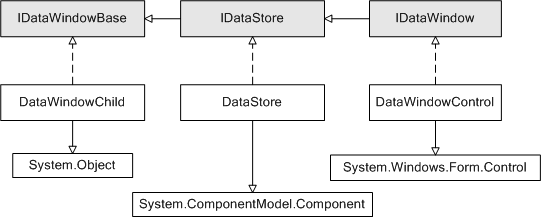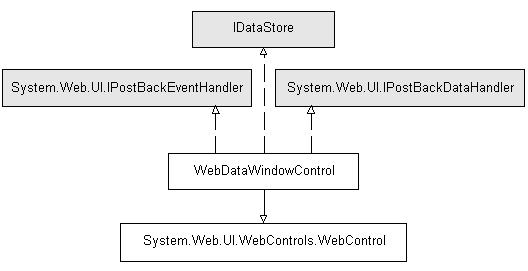Figure 1-2 shows the relationships among the three main classes used in Windows form applications and the three main interfaces that make up DataWindow .NET. (The WebDataWindowControl class hierarchy is shown in Figure 1-3.)
Figure 1-2: DataWindow .NET object model major components

The base interface, IDataWindowBase, defines methods such as Retrieve and UpdateData. The DataWindowChild class implements IDataWindowBase and extends the .NET System.Object class. A DataWindowChild object can be a DataWindow object that is nested inside another DataWindowControl or DataStore object. It can also be used as a drop-down DataWindow object in a column in another DataWindow object. A common use of a drop-down DataWindow object is a list of states, provinces, or countries.
The IDataStore interface extends IDataWindowBase and adds two properties, LibraryList and DataWindowObject, that let you associate a DataWindow object with a DataStore. It also adds methods, such as methods for getting and setting columns, and events that fire at various stages of retrieving, printing, and updating data.
The DataStore class implements IDataStore and extends the .NET System.ComponentModel.Component class.
The IDataWindow interface extends IDataStore and adds methods and events that relate to the visual display of data.
The DataWindowControl class implements IDataWindow and extends the .NET System.Windows.Form.Control class, from which it inherits properties, methods, and events.
The WebDataWindowControl class is defined in the Sybase.DataWindow.Web namespace and is delivered in the WebDataWindow.dll assembly.
The class extends the .NET System.Web.UI.WebControls.WebControl class. It implements the IPostBackEventHandler and IPostBackDataHandler interfaces to handle client-side postbacks, and the IDataStore interface to enable ShareData, RowsCopy, and RowsMove methods to be called between the WebDataWindowControl and DataStore.
Internally, the WebDataWindowControl uses an instance of the DataStore class to expose methods and properties and render the DataWindow in the selected rendering format.
Figure 1-3: WebDataWindowControl class hierarchy
